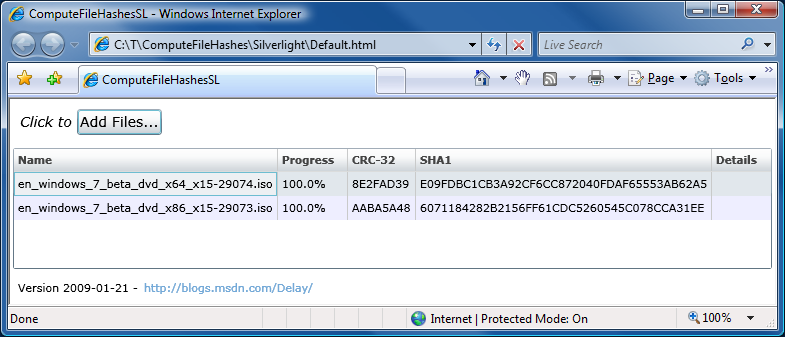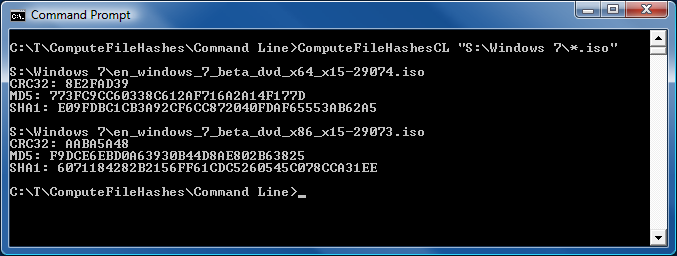Gratuitous platform support [ComputeFileHashes works on the command-line, on WPF, on Silverlight, and via ClickOnce!]
Last week, I released the ComputeFileHashes tool for calculating file checksums. (To read more about what checksums are and why they're useful, please refer to that post.) ComputeFileHashes is a fairly simple .NET command-line application for calculating the MD5, SHA-1, and CRC-32 hashes of one or more files. It takes advantage of the multi-processing capabilities of today's hardware to complete that task quickly - roughly on par with native-code implementations. ComputeFileHashes works quite well and I happily used it to verify the recently released Windows 7 Beta ISO images I'd downloaded.
Because not everybody is a fan of command-line tools, I thought it would be nice to use WPF to create a more user-friendly version of ComputeFileHashes. Once I'd done that, I knew it would be a trivial matter to publish the WPF version via ClickOnce to enable an absurdly easy install scenario. From there, porting to Silverlight would be straightforward and would offer an install-free, completely web-based solution with cross-platform (ex: PC/Mac), cross-browser (ex: IE/Firefox/Safari) appeal. What's more, because all of these platforms are built on .NET, so I expected to be able to take significant advantage of code sharing!



Implementation notes:
- The command-line version of ComputeFileHashes is a standard .NET 2.0 application and should work pretty much everywhere. The Silverlight version requires Silverlight 2 which is tiny and can be completely installed in less than a minute start-to-finish. The WPF/ClickOnce versions are a little more advanced and require .NET 3.5 SP1 (conveniently pre-installed on all Windows 7 machines!). If you don't already have .NET 3.5 SP1 (and you may not because Windows Update still doesn't seem to offer it), you can get the .NET 3.5 SP1 installer from here. Unfortunately, the only indication of .NET 3.5 SP1 not being installed seems to be an application crash immediately after starting the stand-alone WPF version. :( Fortunately, the ClickOnce version knows about the .NET 3.5 SP1 prerequisite and should offer to install it automatically if it's not already present.
- None of the computation or file processing is performed on the main user interface thread under WPF or Silverlight, so ComputeFileHashes remains responsive even when working on a large file. Additional files can be queued for processing or the application/browser can be closed without the user having to wait.
- As I hoped, I was able to achieve a very high degree of code sharing. By refactoring the original ComputeFileHashes code slightly, I pulled the core implementation out into a common class/file that everything shares. Then I put nearly all of the user interface functionality into another class/file that the WPF and Silverlight implementations both share. The XAML for the WPF and Silverlight versions is separate, but very similar. (There are enough slight differences between the two versions that I deliberately did not attempt to share the same XAML file.)
- The source code structure looks like this:
ComputeFileHashesCore.csCore implementation of the file hashing code shared by all implementations. Makes use of multiple threads to perform hash calculations in parallel. ComputeFileHashesUI.csUser interface code shared by the WPF and Silverlight implementations. Makes use of a worker thread to push all computation off of the user interface thread and keep the application responsive. Defers to ComputeFileHashesCore for hashing functionality. CRC32.cs
WaitingRoom.csCustom CRC-32 HashAlgorithm implementation and synchronization object shared by all implementations. HashFileInfo.cs
BlockingQueue.csData object for tracking state and custom Queue subclass that are shared by the WPF and Silverlight implementations. ComputeFileHashesCL\
ComputeFileHashesCL.csCommand-line interface for handling arguments and displaying progress. Defers to ComputeFileHashesCore for hashing functionality. ComputeFileHashesWPF\
Window1.xaml
Window1.xaml.csWPF definition of the application window. Defers to ComputeFileHashesUI for nearly all functionality. ComputeFileHashesSL\
Page.xaml
Page.xaml.csSilverlight definition of the application window. Defers to ComputeFileHashesUI for nearly all functionality. - A look at the screenshots above reveals a few differences between the WPF and Silverlight implementations:
- The DataGrids look different. On WPF, ComputeFileHashes makes use of the WPFToolkit's DataGrid; on Silverlight it uses the DataGrid in the SDK. The two are very similar to use from a developer perspective, but they draw themselves differently and have some slightly user-level functionality changes due to platform differences. This was actually my first experience with either DataGrid and I was happy to find that they both worked the same - and pretty much the way I expected them to!
- The Silverlight version does not calculate the MD5 hash. This is because Silverlight's .NET doesn't implement the MD5 HashAlgorithm subclass while the desktop's .NET does. MD5 is not trivial to write, so I wasn't too interested in developing my own implementation like I did for CRC-32 (which isn't supported on any .NET platform).
- The Silverlight version includes a "Details" column that's not present on the WPF version. On WPF, it's trivial to create a ToolTip for a DataGrid column, but on Silverlight the ToolTipService class must be used and my attempts to set its attached property with a Style were met with ... resistance. So if an exception is thrown when processing a file, the WPF version will show the exception text in a ToolTip while the Silverlight version shows it in the Details column.
- The Silverlight version does not support drag-and-drop from the Windows Explorer. Running within a browser imposes certain limitations on Silverlight; an inability to integrate quite as richly with the operating system is one of them.
- The hyperlinks aren't quite the same. Silverlight ships with HyperlinkButton which is exactly the right control for the job here. WPF doesn't have that control, so the similar Hyperlink control is made to behave as desired with a small bit of code.
In the original release announcement, I wrote that "ComputeFileHashes is a simple tool intended to make verifying checksums easy for anyone.". Well, that's still the case - and adding support for WPF, ClickOnce, and Silverlight should make it even easier for everyone to use. Just decide what kind of user interface you prefer, and start using that version of ComputeFileHashes for all your checksumming needs! :)